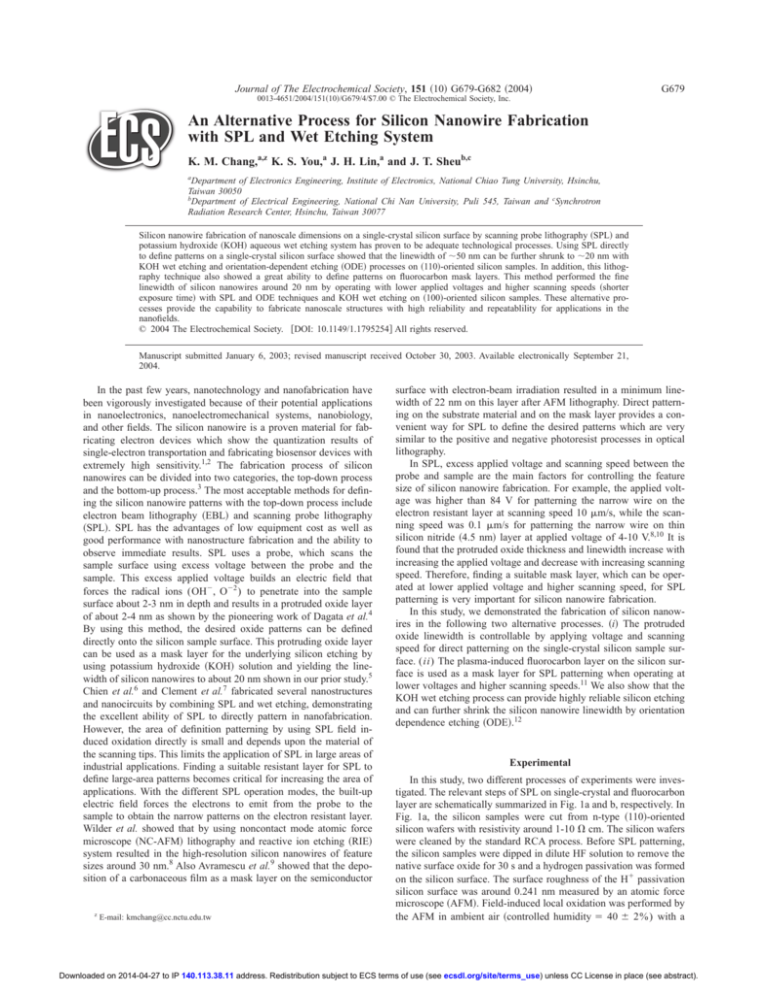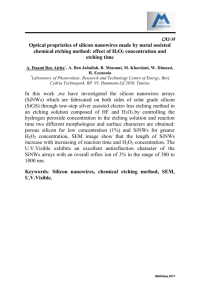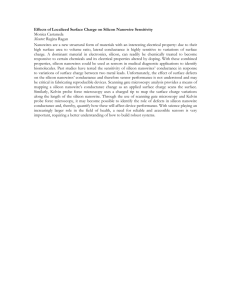
Journal of The Electrochemical Society, 151 共10兲 G679-G682 共2004兲
G679
0013-4651/2004/151共10兲/G679/4/$7.00 © The Electrochemical Society, Inc.
An Alternative Process for Silicon Nanowire Fabrication
with SPL and Wet Etching System
K. M. Chang,a,z K. S. You,a J. H. Lin,a and J. T. Sheub,c
a
Department of Electronics Engineering, Institute of Electronics, National Chiao Tung University, Hsinchu,
Taiwan 30050
b
Department of Electrical Engineering, National Chi Nan University, Puli 545, Taiwan and cSynchrotron
Radiation Research Center, Hsinchu, Taiwan 30077
Silicon nanowire fabrication of nanoscale dimensions on a single-crystal silicon surface by scanning probe lithography 共SPL兲 and
potassium hydroxide 共KOH兲 aqueous wet etching system has proven to be adequate technological processes. Using SPL directly
to define patterns on a single-crystal silicon surface showed that the linewidth of ⬃50 nm can be further shrunk to ⬃20 nm with
KOH wet etching and orientation-dependent etching 共ODE兲 processes on 共110兲-oriented silicon samples. In addition, this lithography technique also showed a great ability to define patterns on fluorocarbon mask layers. This method performed the fine
linewidth of silicon nanowires around 20 nm by operating with lower applied voltages and higher scanning speeds 共shorter
exposure time兲 with SPL and ODE techniques and KOH wet etching on 共100兲-oriented silicon samples. These alternative processes provide the capability to fabricate nanoscale structures with high reliability and repeatablility for applications in the
nanofields.
© 2004 The Electrochemical Society. 关DOI: 10.1149/1.1795254兴 All rights reserved.
Manuscript submitted January 6, 2003; revised manuscript received October 30, 2003. Available electronically September 21,
2004.
In the past few years, nanotechnology and nanofabrication have
been vigorously investigated because of their potential applications
in nanoelectronics, nanoelectromechanical systems, nanobiology,
and other fields. The silicon nanowire is a proven material for fabricating electron devices which show the quantization results of
single-electron transportation and fabricating biosensor devices with
extremely high sensitivity.1,2 The fabrication process of silicon
nanowires can be divided into two categories, the top-down process
and the bottom-up process.3 The most acceptable methods for defining the silicon nanowire patterns with the top-down process include
electron beam lithography 共EBL兲 and scanning probe lithography
共SPL兲. SPL has the advantages of low equipment cost as well as
good performance with nanostructure fabrication and the ability to
observe immediate results. SPL uses a probe, which scans the
sample surface using excess voltage between the probe and the
sample. This excess applied voltage builds an electric field that
forces the radical ions (OH⫺, O⫺2 ) to penetrate into the sample
surface about 2-3 nm in depth and results in a protruded oxide layer
of about 2-4 nm as shown by the pioneering work of Dagata et al.4
By using this method, the desired oxide patterns can be defined
directly onto the silicon sample surface. This protruding oxide layer
can be used as a mask layer for the underlying silicon etching by
using potassium hydroxide 共KOH兲 solution and yielding the linewidth of silicon nanowires to about 20 nm shown in our prior study.5
Chien et al.6 and Clement et al.7 fabricated several nanostructures
and nanocircuits by combining SPL and wet etching, demonstrating
the excellent ability of SPL to directly pattern in nanofabrication.
However, the area of definition patterning by using SPL field induced oxidation directly is small and depends upon the material of
the scanning tips. This limits the application of SPL in large areas of
industrial applications. Finding a suitable resistant layer for SPL to
define large-area patterns becomes critical for increasing the area of
applications. With the different SPL operation modes, the built-up
electric field forces the electrons to emit from the probe to the
sample to obtain the narrow patterns on the electron resistant layer.
Wilder et al. showed that by using noncontact mode atomic force
microscope 共NC-AFM兲 lithography and reactive ion etching 共RIE兲
system resulted in the high-resolution silicon nanowires of feature
sizes around 30 nm.8 Also Avramescu et al.9 showed that the deposition of a carbonaceous film as a mask layer on the semiconductor
z
E-mail: kmchang@cc.nctu.edu.tw
surface with electron-beam irradiation resulted in a minimum linewidth of 22 nm on this layer after AFM lithography. Direct patterning on the substrate material and on the mask layer provides a convenient way for SPL to define the desired patterns which are very
similar to the positive and negative photoresist processes in optical
lithography.
In SPL, excess applied voltage and scanning speed between the
probe and sample are the main factors for controlling the feature
size of silicon nanowire fabrication. For example, the applied voltage was higher than 84 V for patterning the narrow wire on the
electron resistant layer at scanning speed 10 m/s, while the scanning speed was 0.1 m/s for patterning the narrow wire on thin
silicon nitride 共4.5 nm兲 layer at applied voltage of 4-10 V.8,10 It is
found that the protruded oxide thickness and linewidth increase with
increasing the applied voltage and decrease with increasing scanning
speed. Therefore, finding a suitable mask layer, which can be operated at lower applied voltage and higher scanning speed, for SPL
patterning is very important for silicon nanowire fabrication.
In this study, we demonstrated the fabrication of silicon nanowires in the following two alternative processes. 共i兲 The protruded
oxide linewidth is controllable by applying voltage and scanning
speed for direct patterning on the single-crystal silicon sample surface. (ii) The plasma-induced fluorocarbon layer on the silicon surface is used as a mask layer for SPL patterning when operating at
lower voltages and higher scanning speeds.11 We also show that the
KOH wet etching process can provide highly reliable silicon etching
and can further shrink the silicon nanowire linewidth by orientation
dependence etching 共ODE兲.12
Experimental
In this study, two different processes of experiments were investigated. The relevant steps of SPL on single-crystal and fluorocarbon
layer are schematically summarized in Fig. 1a and b, respectively. In
Fig. 1a, the silicon samples were cut from n-type 共110兲-oriented
silicon wafers with resistivity around 1-10 ⍀ cm. The silicon wafers
were cleaned by the standard RCA process. Before SPL patterning,
the silicon samples were dipped in dilute HF solution to remove the
native surface oxide for 30 s and a hydrogen passivation was formed
on the silicon surface. The surface roughness of the H⫹ passivation
silicon surface was around 0.241 nm measured by an atomic force
microscope 共AFM兲. Field-induced local oxidation was performed by
the AFM in ambient air 共controlled humidity ⫽ 40 ⫾ 2%) with a
Downloaded on 2014-04-27 to IP 140.113.38.11 address. Redistribution subject to ECS terms of use (see ecsdl.org/site/terms_use) unless CC License in place (see abstract).
G680
Journal of The Electrochemical Society, 151 共10兲 G679-G682 共2004兲
Figure 1. 共a兲 Process flow chart of SPL for direct patterning on the 共110兲oriented silicon sample followed by the wet etching process in 34 wt % KOH
solution. 共b兲 The process flow of SPL on the fluorocarbon layer and KOH
wet etching process after dipping the sample in dilute HF solution to remove
the induced oxide.
highly doping silicon cantilever tip 共resistivity 0.01-0.0025 ⍀ cm
and diameter, ⬃10 nm, Nanosensors兲. After AFM local oxidation,
the samples were dipped in a 34 wt % KOH solution at temperature
of 50°C with acoustic agitation. The other experiments are shown in
Fig. 1b. The silicon samples were cut from p-type 共100兲-oriented
silicon wafers with resistivity 0.01-0.001 ⍀ cm. The fluorocarbon
layer was formed by an inductively coupled plasma 共ICP兲 dry etching system with 40 sccm CF4 gas source, an rf power of 400 W, and
dc power of 100 W at 60°C for 20 s. The local oxidation was
performed by AFM under the same conditions as the process shown
in Fig. 1a. After local oxidation, the samples were dipped in dilute
HF for 30 s to remove the field-induced oxide and sequentially
dipped in 34 wt % KOH solution at temperature 40°C.
Results and Discussion
We had two groups of experiments, 共i兲 SPL directly patterned on
共110兲-oriented single-crystal silicon sample and (ii) SPL patterned
on the plasma-induced fluorocarbon layer, which was constructed
from 共100兲-oriented single-crystal silicon sample by ICP. Each
sample was etched by the KOH solution along with the orientation
dependent etching 共ODE兲 technique and finally obtained the silicon
nanowire of about ⬃20 nm.
The effects of scanning speed and probe/sample voltage are
equivalent to exposure time and intensity of optical lithography,
respectively. The results of probe/sample voltage on SPL process are
shown in Fig. 2a. The variation of voltage was from ⫺4 to ⫺10 V,
and the scanning speed was maintained at 1 m/s. The AFM was
operated in contact mode, and the contact force was set at a constant
value 共10 nN兲. The thickness 共h兲 of the protruded oxide was from
2.8 nm 共⫺10 V兲 to 0.6 nm 共⫺5 V兲 and could not be identified at ⫺4
V. The thickness of the protruded oxide was linearly proportional to
the applied voltage from ⫺5 to ⫺9 V due to the built up electric
field which was also linearly proportional to the probe/sample voltage. The effect of scanning speed was observed at voltages ⫺10 and
⫺9 V. The protruded oxides were 2.8 nm for ⫺10 V and 2.7 nm for
⫺9 V, respectively. We found that the protruded oxide was dominated by the scanning speed at scanning speed 1 m/s for the ap-
Figure 2. 共a兲 Single-crystal silicon sample showing the oxide height and
depth, induced by SPL local oxidation. The linear region appears at ⫺5 to
⫺8 V and the scanning speed dominant region appears at ⫺9 to ⫺10 V. 共b兲
The fluorocarbon layer showing the oxide height and depth. The linear region appears at ⫺1 to ⫺6 V, and the scanning speed dominant region appears
at ⫺7 to ⫺10 V.
plied voltage equal to ⫺10 V. In this case, the negative radical ions,
such as OH⫺, O⫺2 , did not completely penetrate the silicon surface
at this scanning speed 共exposure time兲. The depth 共d兲 of the penetrated oxide also demonstrated a similar result as the protruded
oxide. The conversion ratios (h ⫹ d)/d of the applied voltage 共⫺5
to ⫺10 V兲 were 3.95, 2.84, 3.87, 2.77, 3.03, and 2.94, respectively,
and the conversion ratio was equal to 2.27 for thermal oxide. The
higher conversion ratio indicates that the induced oxide layer is
weak for masking the silicon during the sequence KOH etching
process.13 This characteristic implies the oxide quality is an important factor for the underlying wet etching process.
For the case of SPL with fluorocarbon mask layer, the effect of
probe/sample voltage on oxidation is shown in Fig. 2b. The contact
force, scanning speed, and humidity of the ambient were 10 nN, 1
m/s, and 40 ⫾ 2%, respectively. The results were similar to Fig.
2a, which included a linear region and a saturation region in which
the scanning speed is dominant. The linear region occurs from ⫺1 to
⫺7 V, and the scanning speed dominant region occurs at ⫺7 to ⫺10
V. The scanning speed dominant region appeared at the lower applied voltage ca. ⫺7 V instead of ⫺9 V as in prior experimental
results. The reason is that the plasma induced the defects on the
Downloaded on 2014-04-27 to IP 140.113.38.11 address. Redistribution subject to ECS terms of use (see ecsdl.org/site/terms_use) unless CC License in place (see abstract).
Journal of The Electrochemical Society, 151 共10兲 G679-G682 共2004兲
G681
Figure 3. 共a兲 The SEM cross-sectional image of silicon nanowires on 共110兲oriented silicon sample. 共b兲 Closed view of the nanowire showing the linewidth of ⬃30 nm with a tilt angle. 共c兲 The real linewidth is about 20 nm
measured by SEM top view image.
surface layer of the 共100兲-oriented silicon sample. These defects
reduced the energy barrier of penetration and enhanced the radical
ions to penetrate the deeper location in the same scanning speed
共exposure time兲 such that the depth of induced oxide was deeper
than the one in Fig. 2a, respectively. The thickness of the fluorocarbon layer was ⬃25 Å, measured by a scanning auger microscope
共SAM兲, and the major elements were Si, C, O, and F. The conversion ratios of the fluorocarbon layer were reduced to values between
1.82-2.48. The possible reason is that the defects also increased the
induced oxide depth d. These defects provided more space for radical ions to convert into the oxide and resulted in the smaller height
of the protruded part h at the same humidity and condition of the
quantity of radical ions.
After SPL local oxidation, the underlying desired patterns were
performed by the aqueous KOH wet etching system. In Fig. 3, the
linewidth of oxide patterns was ⬃50 nm before etching and was
further shrunk to ⬃20 nm by ODE. ODE is a method whereby using
different orientation planes have different etching rates, depending
upon the number of chemical bonds, to etch the desired patterns.
The etching rate ratio of 共110兲:共100兲:共111兲 was 400:200:1 in this
study at an etching temperature of 50°C. The 50 nm oxide patterns
were generated by ⫺8 V of applied voltage and 1 m/s of scanning
speed. At this condition, the total thickness of the induced oxide was
⬃3 nm which was thick enough to protect the underlying silicon
during KOH wet etching at a temperature of 50°C.
Figure 4a shows the top-view AFM image of the nanowire structure, fabricated by using a fluorocarbon mask layer. The surface
roughness (Rq) of the fluorocarbon layer was 0.734 nm before etching and 0.844 nm after 34 wt % KOH etching for 90 s at an etching
temperature 40°C. Figure 4b shows the 3D image of Fig. 4a. The
surface roughness remains very well intact after etching and the
fluorocarbon layer showed a perfect ability to protect the underlying
silicon. The line width was ⬃90 nm and the depth was ⬃100 nm.
The orientation of the sidewall plane is 共100兲-oriented, which has
the same etching rate as the top plane and the 共100兲-oriented plane
has a middle etching rate 关faster than 共111兲-oriented, slower than
共110兲-oriented兴 to which the nanowire can be further shrunk by controlling the etching time. Figure 4d shows the shrunk nanowires
with ⬃20 nm of linewidth and 300 nm of depth. The two left
nanowires in the figure show the overetching results at the end of
line edge.
Conclusions
We have demonstrated the process of scanning probe lithography
共SPL兲 to define the nanopatterns on the silicon surface and on the
fluorocarbon layer. In combination with the KOH wet etching process, the silicon nanowire with ⬃20 nm of linewidth was easily
obtained and the surface roughness could be improved by using the
fluorocarbon mask layer. SPL and KOH wet etching provide high
reliability and uniformity to fabricate nanostructures, which have
been widely implemented in nanoelectron devices, biosensors, and
nanoelectromechanical systems.
Downloaded on 2014-04-27 to IP 140.113.38.11 address. Redistribution subject to ECS terms of use (see ecsdl.org/site/terms_use) unless CC License in place (see abstract).
G682
Journal of The Electrochemical Society, 151 共10兲 G679-G682 共2004兲
Figure 4. 共a兲 The top view image measured by AFM. 共b兲 The AFM 3D image nanotrench width is ⬃150 nm and the nanowire linewidth is ⬃90 nm after KOH
etching for 120 s at etching temperature 40°C. 共c兲 The silicon nanowire is ⬃90 nm and the trench width is ⬃180 nm measured by SEM. The silicon nanowire
with linewidth ⬃20 nm was obtained with the sidewall shrinking process. 共d兲 The overetching condition shows in the left two nanowires.
References
1. Y. Cui and C. M. Lieber, Science, 291, 851 共2002兲.
2. Y. Cui, Q. Wei, H. Park, and C. M. Lieber, Science, 293, 1289 共2001兲.
3. M. K. Sunkara, S. Sharma, R. Miranda, G. Lian, and E. C. Dickey, Appl. Phys.
Lett., 79, 1546 共2001兲.
4. J. A. Dagata and W. Tseng, Appl. Phys. Lett., 62, 591 共1993兲.
5. J. T. Sheu, K. S. You, C. H. Wen, and K. M. Chang, in Proceeding of IEEE-NANO2001, 213 共2001兲.
6. F. S.-S. Chien, W.-F. Hsieh, S. Gwo, A. E. Vladar, and J. A. Dagata, J. Appl. Phys.,
91, 10044 共2002兲.
7. N. Clement, A. Francinelli, D. Tonneau, Ph. Scotto, F. Jandard, H. Dallaporta, V.
Safarov, D. Fraboulet, and J. Gautier, Appl. Phys. Lett., 82, 1727 共2003兲.
8. K. Wilder, C. F. Quate, D. Adderton, R. Bemstein, and V. Elings, Appl. Phys. Lett.,
73, 2527 共1998兲.
9. A. Avramescu, A. Ueta, K. Uesugi, and I. Suemune, Appl. Phys. Lett., 72, 716
共1998兲.
10. F. S.-S. Chien, J. W. Chang, S. W. Lin, Y. C. Chuo, T. T. Chen, S. Gwo, T. S. Chao,
and W. F. Hsieh, Appl. Phys. Lett., 76, 360 共2000兲.
11. G. S. Oehrlein and Y. H. Lee, J. Vac. Sci. Technol. A, 5, 1585 共1987兲.
12. K. Sato, M. Shikida, Y. Matsushima, T. Yamashiro, K. Asaumi, Y. Iriye, and M.
Yamamoto, Sens. Actuators, A, 64, 87 共1998兲.
13. K. Morimoto, F. Perez-Murano, and J. A. Dagata, Appl. Surf. Sci., 158, 205 共2000兲.
Downloaded on 2014-04-27 to IP 140.113.38.11 address. Redistribution subject to ECS terms of use (see ecsdl.org/site/terms_use) unless CC License in place (see abstract).







